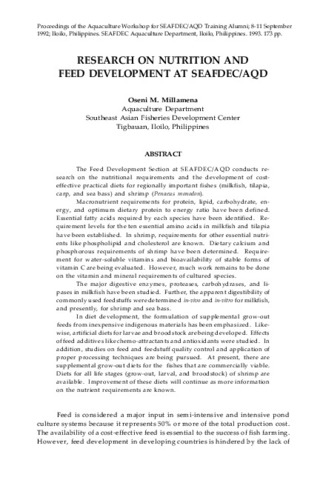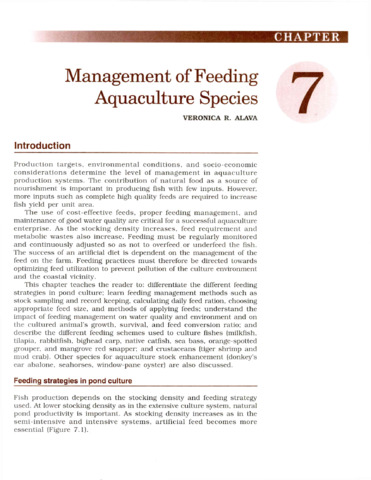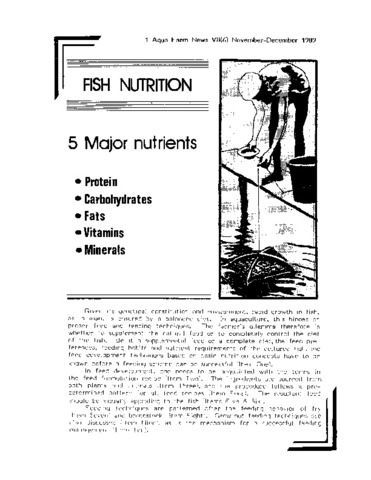Research on nutrition and feed development at SEAFDEC/AQD
| dc.contributor.author | Millamena, Oseni M. | |
| dc.contributor.editor | Villegas, Cesar T. | |
| dc.contributor.editor | Castaños, Milagros T. | |
| dc.contributor.editor | Lacierda, Rodrigo B. | |
| dc.date.accessioned | 2011-06-22T09:35:27Z | |
| dc.date.available | 2011-06-22T09:35:27Z | |
| dc.date.issued | 1993 | |
| dc.identifier.citation | Millamena, O. M. (1993). Research on nutrition and feed development at SEAFDEC/AQD. In C. T. Villegas, M. T. Castaños, & R. B. Lacierda (Eds.), Proceedings of the Aquaculture Workshop for SEAFDEC/AQD Training Alumni, 8-11 September 1992, Iloilo, Philippines (pp. 143-154). Tigbauan, Iloilo, Philippines: Aquaculture Department, Southeast Asian Fisheries Development Center. | en |
| dc.identifier.isbn | 9718511253 | |
| dc.identifier.uri | http://hdl.handle.net/10862/362 | |
| dc.description.abstract | The Feed Development Section at SEAFDEC/AQD conducts research on the nutritional requirements and the development of costeffective practical diets for regionally important fishes (milkfish, tilapia, carp, and sea bass) and shrimp (Penaeus monodon). Macronutrient requirements for protein, lipid, carbohydrate, energy, and optimum dietary protein to energy ratio have been defined. Essential fatty acids required by each species have been identified. Requirement levels for the ten essential amino acids in milkfish and tilapia have been established. In shrimp, requirements for other essential nutrients like phospholipid and cholesterol are known. Dietary calcium and phosphorous requirements of shrimp have been determined. Requirement for water-soluble vitamins and bioavailability of stable forms of vitamin C are being evaluated. However, much work remains to be done on the vitamin and mineral requirements of cultured species. The major digestive enzymes, proteases, carbohydrases, and lipases in milkfish have been studied. Further, the apparent digestibility of commonly used feedstuffs were determined in-vivo and in-vitro for milkfish, and presently, for shrimp and sea bass. In diet development, the formulation of supplemental grow-out feeds from inexpensive indigenous materials has been emphasized. Likewise, artificial diets for larvae and broodstock are being developed. Effects of feed additives like chemo-attractants and antioxidants were studied. In addition, studies on feed and feedstuff quality control and application of proper processing techniques are being pursued. At present, there are supplemental grow-out diets for the fishes that are commercially viable. Diets for all life stages (grow-out, larval, and broodstock) of shrimp are available. Improvement of these diets will continue as more information on the nutrient requirements are known. | en |
| dc.language.iso | en | en |
| dc.publisher | Aquaculture Department, Southeast Asian Fisheries Development Center | en |
| dc.subject | Oreochromis | en |
| dc.subject | Lates calcarifer | en |
| dc.subject | Philippines | en |
| dc.subject | Giant perch | en |
| dc.subject | milkfish | en |
| dc.title | Research on nutrition and feed development at SEAFDEC/AQD | en |
| dc.type | Conference paper | en |
| dc.citation.spage | 143 | |
| dc.citation.epage | 154 | |
| dc.citation.conferenceTitle | Proceedings of the Aquaculture Workshop for SEAFDEC/AQD Training Alumni, 8-11 September 1992, Iloilo, Philippines | en |
| dc.subject.asfa | diet | en |
| dc.subject.asfa | feed preparation | en |
| dc.subject.asfa | feeds | en |
| dc.subject.asfa | shrimp culture | en |
| dc.subject.asfa | lipids | en |
| dc.subject.asfa | enzymes | en |
| dc.subject.asfa | cultured organisms | en |
| dc.subject.asfa | energy budget | en |
| dc.subject.asfa | vitamins | en |
| dc.subject.asfa | nutritional requirements | en |
| dc.subject.asfa | fatty acids | en |
| dc.subject.asfa | proteins | en |
| dc.subject.asfa | carbohydrates | en |
| dc.subject.asfa | fish culture | en |
| dc.subject.scientificName | Hypophthalmichthys nobilis | |
| dc.subject.scientificName | Lates calcarifer | en |





